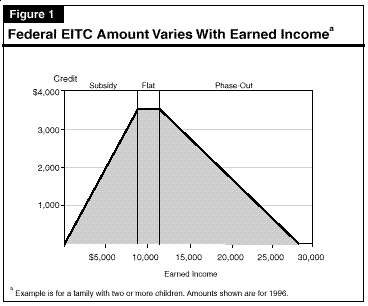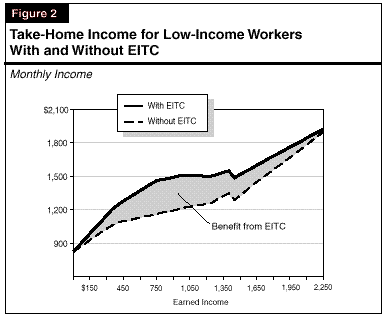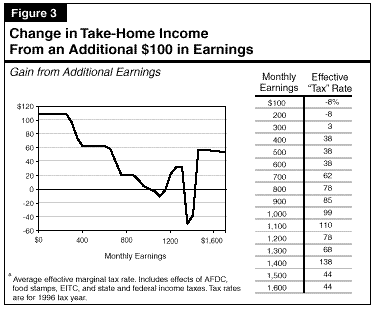
What Is the EITC? How Does It Affect the Work Incentives and Tax Burden of Lower-Income Workers? |
SummaryAs the Legislature considers how to reform the welfare system, discussion has centered on how to move welfare recipients to work. In considering how best to help lower-income Californians, the Legislature will have to keep in mind such factors as work incentives for welfare recipients as well as the tax incentives and relative tax burden that lower-income workers face. One significant work incentive and income redistribution program at the federal level is the Earned Income Tax Credit (EITC).The federal EITC is a refundable tax credit that supplements the earnings of low-income workers. The EITC is designed to provide a work incentive and to redistribute income to low-income workers. In general, the federal EITC does appear to accomplish these goals for the lowest income workers. However, the EITC may also have the effect of discouraging additional work effort for certain workers. Specifically, once earnings exceed about $1,000 per month, EITC benefits are phased out, creating a work disincentive. Therefore, the EITC presents an inherent trade-off: greater benefits to the lowest income workers have the effect of increasing work disincentives for those in the phase-out range of the program. In considering the merits of a state version of the EITC, the Legislature will need to consider several important factors:
This piece provides background and analysis of the federal EITC. An understanding of the federal program can inform the Legislature's discussions of whether to consider a state EITC. |
As the Legislature considers how to implement the federal welfare reform law, much discussion has centered on how to provide an increased incentive to move welfare recipients to work. In considering how best to help lower-income Californians, the Legislature will have to keep in mind such factors as appropriate work incentives for welfare recipients as well as the tax incentives and relative tax burden that lower-income workers face.
One significant work incentive and income redistribution program at the federal level is the Earned Income Tax Credit (EITC). The EITC is a refundable tax credit that is designed to supplement the earnings of low-income workers. Originally created as a means of reducing the burden on low-income workers of the Social Security tax, the EITC has now become a significant part of the federal anti-poverty effort. In 1994, more than 2.5 million Californians claimed nearly $3 billion in credits from the federal EITC.
Recently, there has been some discussion of adopting a state version of the EITC. An EITC has important implications for both welfare and tax policy. This piece provides background information and analysis of the federal EITC. An understanding of the federal program can inform the Legislature's discussions of whether to consider a state EITC and how such a program, if adopted, could be structured.
The federal EITC provides a refundable tax credit to low-income workers. The credit can be used to offset federal tax liabilities or, for credit amounts in excess of income tax liability, to provide refunds. The amount of the credit depends primarily on the level of earnings and the number of children in the family.
As shown in Figure 1, the federal program has three distinct ranges, depending on the income of the worker:

The original goal of the EITC was to relieve the burden on low-income workers of paying the Social Security tax. Today, however, at least two other goals for the program are commonly discussed:
Beyond the subsidy range, however, the EITC may discourage additional work effort by decreasing the returns to additional work. Because the credit is phased out, each additional dollar of earnings reduces the amount of the credit that a worker receives. The EITC may therefore have the effect of causing workers to work less than they otherwise would.
While empirical research on the subject is somewhat contradictory, and no study has documented the effects of the federal EITC after it was expanded to its current level in 1996, in general the research confirms what theory predicts: The EITC does result in an increase in the number of people working and an increase in the hours of work for workers in the subsidy range. For those already working and earning more than about $750 per month, however, the EITC discourages additional work effort for some workers, causing them to reduce their hours of work.
The extent of these labor force effects--how much more likely a person is to work and how much less existing workers will work--is not clearly established. Most studies, however, have concluded that the effects are stronger in the subsidy range relative to the flat and phase-out ranges. (About 75 percent of eligible workers are in the flat and phase-out ranges, while only 25 percent are in the subsidy range.)
Finally, it is important to note that the incentives created by the EITC must be considered in the context of the complicated set of incentives that a low-income family faces. The decision to work, or to work more, is affected by a variety of other state and federal policies, and a broad range of personal considerations. The impact of the EITC, therefore, depends to a large extent on other factors beyond the scope of the program.
As noted above, the EITC provides both work incentives and work disincentives, depending on the income of the worker. Evaluating the relative importance of these incentives extends beyond a simple economic analysis. A decision to enter the labor force or move to full-time work may have effects that cannot be measured simply in terms of monthly earnings. For example, a worker moving from welfare to work or from part-time to full-time work benefits from achieving or moving toward self-sufficiency. Workers who would not otherwise go to work benefit from establishing a connection with the labor force that can lead to a long-term improvement in their standard of living.
In addition, certain economic factors may mitigate somewhat the disincentive effects of the EITC phase-out. For example, as workers move from part-time to full-time work, many receive health benefits provided by their employer. Perhaps most importantly, full-time workers have significantly greater long-term career prospects and economic benefits relative to part-time workers or those who do not work at all.
Individual workers may respond more to the perceived benefits of self-sufficiency or long-term implications than to the immediate financial disincentives to working more posed by the EITC. Thus, evaluating the current federal EITC requires weighing both the short- and long-term benefits of increased labor force participation and increased hours of work for some against the costs of reduced work effort for others.
EITC Involves Inherent Tradeoffs. As with any means-tested program, the EITC confronts an inherent tradeoff. If benefits are to be targeted to lower-income persons, then the program must have a phase-out. A program that phases out quickly will provide benefits primarily to the intended beneficiaries and will therefore be less costly relative to a program that phases out more gradually. However, in phasing out benefits rapidly, such a program creates work disincentives, as discussed above. The current structure of the federal program represents one compromise among these conflicting outcomes.
The EITC, along with other anti-poverty programs, such as Temporary Assistance for Needy Families (TANF) and food stamps, phases out as income increases. Each of these programs is designed to provide an adequate level of support to lower-income individuals and families in order to move them out of poverty. In addition, the EITC is designed to provide work incentives.
The phase-out structure of these programs, however, differ--reflecting the different goals of the programs. The TANF and food stamp programs provide the majority of assistance to those with the very lowest incomes and gradually provide less assistance to families as their earnings increase. While this approach makes sense from the standpoint of targeting limited resources to those most in need, the consequence of the phase-out is that, as low-income workers earn more, many of the benefits for which they would otherwise qualify are reduced. The result is a diminished work incentive for the very lowest-income workers. The structure of the EITC is somewhat different. EITC benefits generally increase over the range in which TANF and food stamp benefits are decreasing, and then decrease as workers earn more.
As workers earn more than about $1,000 per month--or about what a person working full time at the minimum wage would earn--many of the income support benefits begin to fully phase out. Under the current TANF program the grant for a family of three is fully phased out when a worker has earnings of more than about $1,200 per month. Food stamp benefits are phased out completely above earnings of about $1,400 per month for a family of three. EITC benefits increase as earnings increase up to about $740 per month, are flat up to earnings of about $1,000 per month and then gradually phase out.
Working Families Incur Additional Work-Related Costs. In addition to the loss of benefits, working families incur additional costs as they work more. Workers earning more than about $1,130 per month will begin to pay federal income tax. California state income tax is more progressive than the federal income tax. A typical family of three would not start to pay state income tax until earnings exceed about $1,700 per month. As workers work more, they may also begin to incur additional work-related costs such as child care, clothing, health care, and transportation costs.
Figures 2 and Figure 3 show how the take-home or disposable income for a California family of three eligible for TANF, food stamps, and the federal EITC changes as earnings increase.
As the figures indicate, workers stand to achieve significant gains in their take home income as they move from welfare to work. For example, a typical family of three with no earned income receives about $825 per month from a combination of TANF and food stamps. However, the same family with a parent working 20 hours per week at the minimum wage (equivalent to about $400 per month) would have take-home income of about $1,250 from wages, TANF, food stamps, and the EITC.
As workers earn more than this amount, however, the interaction between the various income support programs, income taxes, and work-related expenses creates a disincentive to increase work effort over a certain range of earnings. For example, a worker earning $750 from work


will have a monthly take-home income from work, food stamps, TANF, and the EITC of about $1,460. However, if the same worker doubled earnings from work to $1,500 per month, total take-home income would increase by just $55 per month to $1,515 as a result of the complete phase-out of the TANF grant, the loss of food stamp benefits, income tax payments, and the EITC phase-out.
Low-Income Workers Experience High Marginal "Tax" Rates. One measure of the incentives (or disincentives) a worker faces is to look at how a worker's total take-home income (welfare benefits, if applicable, plus earnings) changes as earnings from work increase. Economists often refer to this comparison as the effective marginal tax rate. Figure 3 shows, for various income levels, how much additional income a working parent of two could expect to take home if earnings increased by $100.
At very low earnings, the federal EITC provides increasing returns to work. As a result, the effective marginal tax rate is negative. In other words, as workers earn an additional $100 of income, their take home pay increases by more than a $100. At somewhat higher income levels, however, the effective marginal tax rates become very high, even exceeding 100 percent at two points (as shown in Figure 3) where the welfare grant and food stamp benefits are phased out as the federal EITC benefits begin to decline. This means that as a worker earns an additional $100, his or her take-home income actually declines by more than $100. As a point of comparison, a family of three with earnings of $4,000 per month would have a combined state and federal marginal tax rate of about 45 percent.
Among the major state and federal anti-poverty programs, the EITC is the only program designed primarily to provide work incentives. Both TANF and food stamps are designed primarily to offer income support. Maximum benefits from these programs generally go to families that are not working, and begin to phase out soon after workers enter the labor force. These programs have a relatively rapid phase-out and provide little or no benefits to families with earnings just over the poverty line.
Benefits from the EITC, however, increase as work effort increases (over a certain range) and only begin to phase out as a family's income increases above the poverty level ($1,081 per month for a family of three in 1996). The structure of the EITC helps to mitigate the disincentives posed by the phase out of TANF and food stamps and provides an additional incentive to enter the labor force. In so doing, however, the EITC
creates additional work disincentives for workers with incomes just above the poverty level.
Both economic theory and empirical evidence suggest that the federal EITC does encourage low-income individuals--including welfare recipients--to go to work, and for those with the very lowest incomes, it encourages them to work more. For welfare recipients, the EITC may mitigate the effects of the phase-out of welfare benefits over a certain range, providing an additional incentive for these individuals to work. It is also the case, however, that the phase out of the EITC creates disincentives for some who are already working. For welfare recipients working part time, these disincentives are particularly important when considered in the context of the phase-out of various welfare programs, which occurs over a relatively narrow income range.
Moreover, it is important to note that the federal program is viewed in part as a general redistributive program using the tax system, as opposed to a more narrowly focused welfare-to-work program. Benefits are not limited to welfare recipients and even extend to families with incomes as high as $28,000 per year. As a result, the EITC has a major fiscal impact at the federal level.
In considering the merits of a state earned income tax credit, the Legislature confronts these inherent tradeoffs. In evaluating these tradeoffs, the Legislature should consider two important factors:
In considering a state EITC, the Legislature faces a fundamental decision about how to invest scarce resources. Is the intent to create a program that will encourage welfare recipients to seek employment? Or, does the Legislature wish to consider a broader program that would aid low-income workers?
If the aim is simply to aid welfare recipients, the Legislature will need to compare the relative benefits and effectiveness of the EITC to those of a more focused direct expenditure program for welfare recipients such as job training or other services. While a focused program would provide benefits only to welfare recipients, a broader tax-based program would provide benefits to all low-income workers. Such a program, however, may be more costly relative to a focused direct expenditure program.
The Legislature--if it chose to adopt an EITC--would also need to decide how it might want to structure the credit. Maximum benefits could go to the very lowest-income workers and those entering the workforce. Or, the program could be designed to aid those low-income workers who face disincentives to working more and "getting ahead" as their welfare and federal EITC benefits are phasing out.